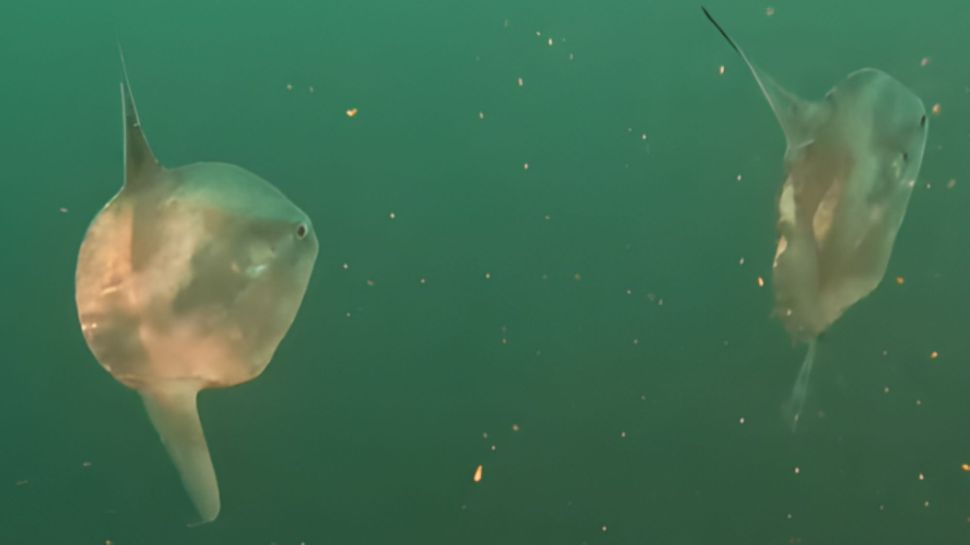Researchers have filmed a pair of young ocean sunfish off Canada’s coast and estimated them to measure 24 inches across — five times smaller than the size they reach in adulthood.
A scuba diver has captured rare footage of two “very young” sunfish swimming in emerald waters off the coast of British Columbia in Canada.
Experts identified the pair as ocean sunfish (Mola mola) and said their angular bellies and small size are telltale signs of their “babyness” in a Facebook post on Oct. 23.
“They look to me like very young Mola mola,” Marianne Nyegaard, a marine biologist specializing in ocean sunfishes and a research associate at the Auckland Museum in New Zealand, said in the Facebook post.
The new footage, taken by citizen scientist Timothy Manuelides north of Port Hardy in the Browning Pass area, shows two glinting sunfish accompanied by a school of widow rockfish (Sebastes entomelas) and yellowtail rockfish (S. flavidus). The sunfish swam away as Manuelides approached them, waving their long dorsal and anal fins like wings through green, sunlit waters.
Researchers noted the sunfish on the right was missing a chunk from its tail. They estimated the juveniles measured around 24 inches (60 centimeters) in diameter. Sunfish are the largest bony fish in the world and can grow to a whopping 10 feet (3 meters) in diameter, so these juveniles were about five times smaller than adult sunfish — but 240 times bigger than their newborn size of just 0.1 inch (2.5 millimeters).
Very little is known about sunfishes’ early lives, and their adorable, bug-size larvae can only be identified at species level via DNA sequencing.

Sunfish are also known as mola (which is also their genus and species name), after the Latin word for a millstone, reflecting the round, flattened shape of their bodies.
The video reveals that sunfish can swim faster than many people assume, the researchers noted in the Facebook post. “They are often erroneously thought to be slow,” Jackie Hildering, a researcher and the education and communications director for the Marine Education and Research Society (MERS) who was on the dive but did not see the sunfish, wrote in the post. Hildering added that this perception results from a “sunning” behavior observed at the ocean surface, where sunfish bask in warm light after spending time in the cold depths.
“They can also be fairly stationary at the surface to present themselves for parasite removal by birds like albatross,” Hildering noted.
Ocean sunfish are found across the world’s oceans, from tropical waters to temperate seas, and spend most of their time between the water’s surface and 660 feet (200 m) deep. They were long thought to be the only species of Mola in the northeast Pacific, until researchers discovered another species — hoodwinker sunfish (Mola tecta), first described in 2017 after specimens washed up on a New Zealand beach and later spotted off the coast of Canada.
To distinguish between hoodwinker sunfish and ocean sunfish, researchers look at the tail, or clavus: The tail of an ocean sunfish has a frilly edge, while the tail of a hoodwinker sunfish is rounded with a central indent.
“This year it is extraordinary that we know of about seven sightings of Mola in the Browning Pass area,” Hildering wrote in the post. A team of researchers is working “to determine if they are repeat sightings of the same fish,” she added.
This video is by Timothy Manuelides and was contributed to the Marine Education and Research Society for research into the two species of Mola or Ocean Sunfish off the west coast of North America. Research Lead, Dr. Marianne Nyegaard from Ocean Sunfish Research, identified that these fish are most likely juvenile Mola mola (Ocean Sunfish), not the other Mola species found in these waters Mola tecta (Hoodwinker Sunfish).